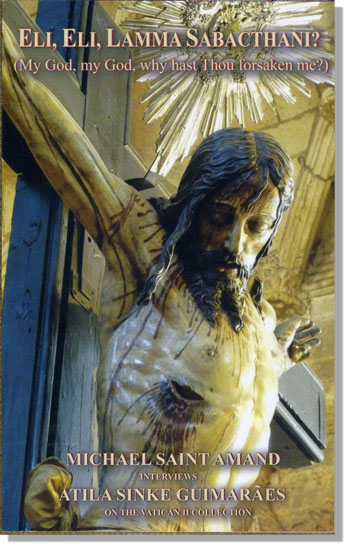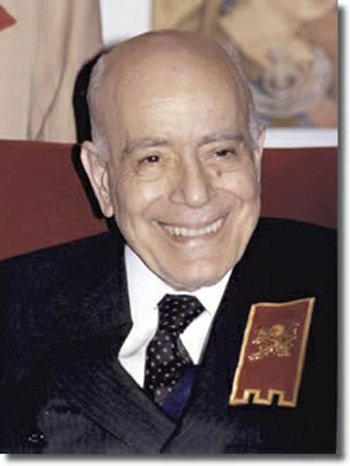Book Reviews
 |
 |
 |
 |
 |
 |
 |
A Manual that Inspires Militancy
Book review of Eli, Eli, Lamma Sabacthani? – Michael Saint Amand Interviews Atila S. Guimarães on his Collection on Vatican II, Los Angeles: TIA, 2017, 96 pp.

Purchase here
Shortly afterwards, Michael Saint Amand, a friend of Atila and supporter of TIA, had the good idea to make the Collection more accessible to the general public by posing a series of questions to the Author, who would explain his inspiration, goals, trials and triumphs in this long process.
The result: 45 well-chosen questions and brilliant, succinct answers that explain many things to the Reader: the reason for the title Eli, Eli, Lamma Sabacthani?, how the idea of writing the Collection was born, and the aims and general order taken by the Author. These Q & A's make most interesting reading.
The Author also defines the goal of the progressivists, which is nothing less than to destroy the Catholic Church as she existed for more than 19 centuries. In a few paragraphs, he explains what moves the progressivist Hierarchy and its sycophants who, moved by human respect, became tolerant toward every evil and error. It has resulted in two opposing Churches – the Catholic Church and the Conciliar Church – “coexisting in the murky waters of confusion.” Such Q & A's make fascinating reading.
Another very useful feature in the small book is the vocabulary section, intended to facilitate an easy reading by defining frequently used words that might require explanations. Personally, I have read all the volumes of the Collection and I would have appreciated having this tool at hand as I progressed, since one volume builds on another, and sometimes a word – e.g. kenosis – is explained in one book and, then, used in a later volume. Coming across the word a second time, the Reader can simply go to the Vocabulary in the booklet for a clear definition. (If you don't know what kenosis is, go to pp. 30-31 in Eli, Eli – it is an important word used by the progressivists to justify the self-destruction of the Church).
The interview section is preceded by biographies of both Atila and his mentor, Prof. Plinio Corrêa de Oliveira, who invited Atila to write and publish the Collection and directed him in the process until his death in 1995. Both life sketches explain the spirit of fight and love for the Holy Church that ultimately inspired and sustained the writing of this Collection.
This booklet leads to Atila's Defense
During his life, Prof. Plinio suffered many defamatory onslaughts against his fight for the Church and Christian Civilization. His disciple, Atila Guimarães, seems slated to follow in his footsteps. Because he obeyed Dr. Plinio's order to publish this well-studied and scholarly analysis of Vatican II, he was expelled from the TFP. The latter has spread the lie that Dr. Plinio never really wanted to engage in a public polemic against Vatican II.
This fabrication is partially exposed in the booklet Eli, Eli, and more thoroughly set out and proved false by Dr. Plinio's own words in the Defense Atila wrote when, in 1997, he was facing the threat of expulsion for publishing the first Volume, In the Murky Waters of Vatican II. I suggest that readers of Eli, Eli peruse that Defense, which they can find here, to have a full picture of what was intended for this Collection on Vatican II.

Prof. Plinio founded a movement that, after his death, abandoned his ideals
This fight against Progressivism is the center of the Revolution and also the very heart of the Counter-Revolution. According to Dr. Plinio, with the secure backing of Atila's Collection on the Council, now was the moment to raise the standard and begin the denunciation, even though he realized that it would probably bring punishment as a consequence.
All this is clearly quoted in the Defense, which, in my opinion, is just a further explanation of the necessity for the Collection. It is also a call to action for those with the genuine Catholic militant spirit to join the fight against the progressivist revolution in the Church. It is a call to utilize this “arsenal” and make an offensive against those who have betrayed the Church. The weapons are there in the Collection, which is available now in English. All that is lacking are the men to disseminate it.
This booklet is a flame to launch a first rocket, a stimulus for an organized attack against the Progressivist Church. In the Defense, Prof. Plinio is quoted as proposing such an initiative. May a grace from Our Lady bring that happy moment when the role of “passive resistance” is abandoned, and an eminently active initiative springs up in order to end this decades-long crisis in the Church caused by Vatican II.

Posted February 21, 2018
______________________
______________________
 Volume I |
 Volume II |
 Volume III |
 Volume IV |
 Volume V |
 Volume VI |
 Volume VII |
 Volume VIII |
 Volume IX |
 Volume X |
 Volume XI |
 Special Edition |


